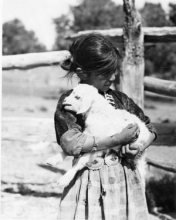Article
A sheep that is less than one year old. Sheep (and lambs) were introduced into the Americas by Spanish explorers in the sixteenth century, along with horses and cattle. Among indigenous American cultures, the Navajo in particular were influenced by their contact with Basque sheepherders, who also were imported to the New World along with their sheep. Navajo traditional culture and economies grew to revolve in part around sheep, including herding, sheering, spinning, and weaving the wool from what are today known as Navajo churro sheep. Navajo weaving is renowned around the world for its quality and its innovative and intricate designs.
Lamb is also a popular form of meat, and when the sheep matures past a year it is called mutton. Mutton stew and roast mutton are today main staples of the Navajo diet.
"Navajo girl with lamb, Navajo Reservation, New Mexico, circa 1955," photograph by New Mexico Tourism Bureau. New Mexico Magazine Collection, Album 28 (HP.2007.20.588). Palace of the Governors Photo Archive, New Mexico History Museum, Santa Fe
Manuscripts
References
Encyclopædia Britannica Online
N.d. Lamb. http://www.britannica.com/EBchecked/topic/328467/lamb, accessed October
13, 2014.
Pritzker, Barry M.
N.d. Native American Weaving. The American Mosaic: The American Indian Experience.
http://americanindian2.abc-clio.com/Search/Display/1463427, accessed January 14,
2015.
Pritzker, Barry M.
N.d. Navajo.The American Mosaic: The American Indian Experience.
http://americanindian2.abc-clio.com/Search/Display/1463209, accessed January 14,
2015.

